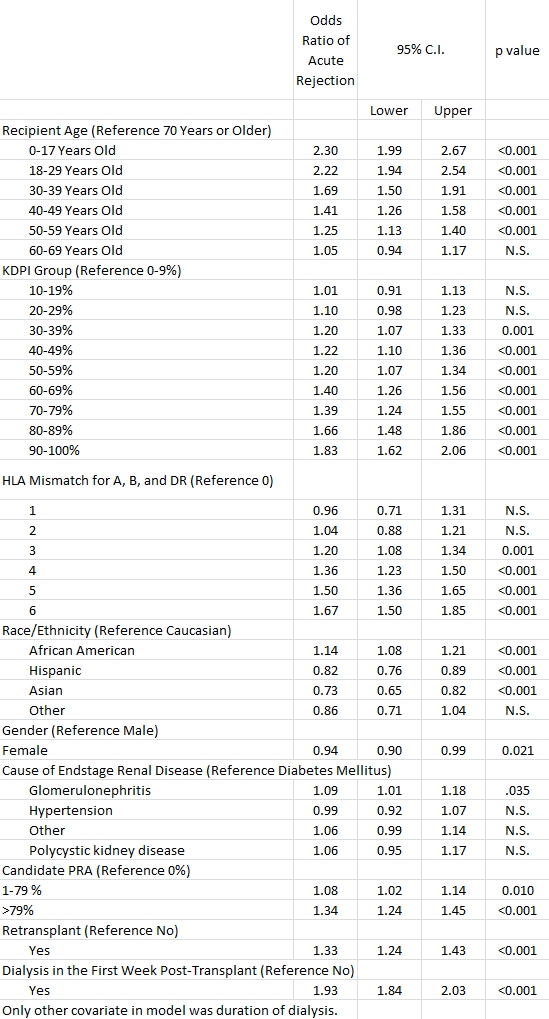Recipient Age and KDPI Are Potent Predictors of Early Acute Rejection in the Modern Era of Deceased Donor Kidney Transplantation.
Medicine, University of Virginia, Charlottesville, VA.
Meeting: 2016 American Transplant Congress
Abstract number: A152
Keywords: Kidney transplantation, Rejection, Risk factors
Session Information
Session Name: Poster Session A: Kidney: Acute Cellular Rejection
Session Type: Poster Session
Date: Saturday, June 11, 2016
Session Time: 5:30pm-7:30pm
 Presentation Time: 5:30pm-7:30pm
Presentation Time: 5:30pm-7:30pm
Location: Halls C&D
The rate of acute rejection in the first six months after deceased donor (DD) kidney transplant is about 10% in the modern era of immunosuppression. This study sought to determine the factors predictive of acute rejection in this era.
Using the SRTR database, all recipients (adult and pediatric) transplanted with a DD kidney (N = 84,083) between January 1st, 2005 and December 31, 2012 were included in the analysis. Patients coded as having an acute rejection in the first six months post-transplant were considered to have an event. Logistic regression was used to determine the odds ratio of acute rejection in the first six months adjusting for multiple covariates.
The acute rejection rate in the first six months post-transplant was 9.4% during the study period with a range of 11.1% in 2005 to 8.3% in 2012. KDPI, recipient age, delayed graft function and HLA mismatch were the most important factors influencing rejection rates. Recipients under 30 years of age had a rate of rejection more than double that of recipients 60 years or older. Recipients receiving donor kidneys with a KDPI over 90% had an odds ratio of 1.83 (p<0.001) for rejection when compared to those receiving a kidney with a KDPI less than 10%. To determine the factors within calculation of the KDPI that contributed to the increase in rejection noted with increasing KDPI, the separate variables were assessed. Donor age, history of hypertension, stroke as a cause of brain death, and hepatitis C virus seropositivity were the only factors that were significantly associated with acute rejection, with age being the most important factor. Donor race, creatinine, height, weight, diabetes, and non-heart beating donors were not associated with an increased risk of rejection.
Recipients under 30 years of age had a rate of rejection more than double that of recipients 60 years or older. Recipients receiving donor kidneys with a KDPI over 90% had an odds ratio of 1.83 (p<0.001) for rejection when compared to those receiving a kidney with a KDPI less than 10%. To determine the factors within calculation of the KDPI that contributed to the increase in rejection noted with increasing KDPI, the separate variables were assessed. Donor age, history of hypertension, stroke as a cause of brain death, and hepatitis C virus seropositivity were the only factors that were significantly associated with acute rejection, with age being the most important factor. Donor race, creatinine, height, weight, diabetes, and non-heart beating donors were not associated with an increased risk of rejection.
KDPI and recipient age are important factors associated with rejection. Older donor kidneys and younger recipients are more prone to acute rejection. This has important implications regarding risk stratification for donor recipient pairs and should be considered when determining induction and maintenance immunosuppression needs.
CITATION INFORMATION: Keith D, Vranic G, Nishio Lucar A. Recipient Age and KDPI Are Potent Predictors of Early Acute Rejection in the Modern Era of Deceased Donor Kidney Transplantation. Am J Transplant. 2016;16 (suppl 3).
To cite this abstract in AMA style:
Keith D, Vranic G, Lucar ANishio. Recipient Age and KDPI Are Potent Predictors of Early Acute Rejection in the Modern Era of Deceased Donor Kidney Transplantation. [abstract]. Am J Transplant. 2016; 16 (suppl 3). https://atcmeetingabstracts.com/abstract/recipient-age-and-kdpi-are-potent-predictors-of-early-acute-rejection-in-the-modern-era-of-deceased-donor-kidney-transplantation/. Accessed December 13, 2025.« Back to 2016 American Transplant Congress
